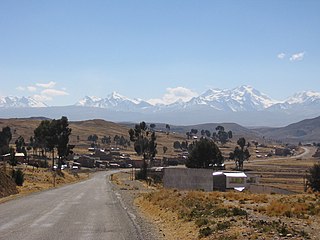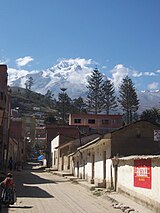Apolo is a location in the Franz Tamayo Province in the La Paz Department, Bolivia, South America, with a population of 2,123 in the year 2001. It is the seat of the Apolo Municipality.

Larecaja is a province in the Bolivian La Paz Department. It was founded by Antonio José de Sucre on October 18, 1826. Its capital is Sorata.

Achacachi is a town on the Altiplano plateau in the South American Andes in the La Paz Department in Bolivia. It is the capital of the Omasuyos Province.

Ancohuma or Janq'u Uma is the third highest mountain in Bolivia. It is located in the northern section of the Cordillera Real, part of the Andes, east of Lake Titicaca. It lies just south of the slightly lower Illampu, near the town of Sorata.

Sorata Municipality is the first municipal section of the Larecaja Province in the La Paz Department, Bolivia. Its capital is Sorata. The Illampu - Janq'u Uma massif is located within the municipality, site of the 17th highest lake in the world, Laguna Glaciar.
Batallas is a location in the La Paz Department in Bolivia. It is the seat of the Batallas Municipality, one of the four municipalities of the Los Andes Province.
Coripata is a town in the La Paz Department, Bolivia.

Puerto Acosta or Waychu (Aymara) is a town in the La Paz Department, Bolivia.

Q'asiri is a mountain in the Cordillera Real in the Andes of Bolivia, about 5,828 m (19,121 ft) high. It is located in the La Paz Department, Larecaja Province, Sorata Municipality. It is situated south-east of the mountain Janq'u Uma, north-west of the mountains Qalsata and Ch'iyar Juqhu and north-east of San Francisco Lake.
Ch'iyar Qullu is a 4,875-metre-high (15,994 ft) mountain in the north of the Cordillera Real in the Andes of Bolivia. It is situated in the La Paz Department, Larecaja Province, Sorata Municipality. Ch'iyar Qullu lies west of the Janq'u Uma-Illampu massif and north-east of the mountain Achachi Qullu (Achachi Kkollu).

Jach'a Pukara is a mountain in the Andes of Bolivia, about 4,300 metres (14,108 ft) high. It is situated in the La Paz Department, Larecaja Province, Sorata Municipality. Jach'a Pukara lies between Lake Titicaca in the west and the Janq'u Uma-Illampu massif of the Cordillera Real in the east.
Wiluyu Janq'u Uma or Wiluyu is a mountain in the Cordillera Real in the Andes of Bolivia, about 5,540 metres (18,176 ft) high. It is located in the La Paz Department, Larecaja Province, Sorata Municipality. It lies northwest of the mountain Yapuchañani, northeast of Misk'i T'ant'a and Uma Jalanta and east of Illampu.
Janq'u K'ark'a is a mountain in the Cordillera Real in the Andes of Bolivia, about 5,200 metres (17,060 ft) high. It is situated in the La Paz Department, Larecaja Province, Sorata Municipality, and in the Omasuyos Province, Achacachi Municipality. Janq'u K'ark'a lies south of the Janq'u Uma-Illampu massif, southeast of the mountain Quña Quñani and the lakes Warawarani (Huara Huarani) and Jisk'a Warawarani (Jiskha Huara Huarani).
Wila Quta is a mountain in the Andes of Bolivia, about 4,960 metres (16,273 ft) high. It is situated in the La Paz Department, Larecaja Province, Sorata Municipality, north of the massif of Janq'u Uma and Illampu of the Cordillera Real. The river Janq'u Uma Jawira originates south of the mountain. It flows to the north-east.
Ch'uch'u Jawira is a Bolivian river in the La Paz Department, Larecaja Province, Sorata Municipality. Its waters flow the Kaka River which belongs to the watershed of the Beni River.
P'iq'iñ Qullu is a mountain in the north of the Cordillera Real in the Andes of Bolivia, about 4,875-metre (15,994 ft) high. It is situated in the La Paz Department, Larecaja Province, Sorata Municipality. P'iq'iñ Qullu lies west of the Janq'u Uma-Illampu massif southeast of Sorata.
Jach'a Apachita is a mountain in the Andes of Bolivia, about 4,420 metres (14,501 ft) high. It is situated in the La Paz Department, Larecaja Province, Sorata Municipality. Jach'a Apachita lies northeast of the Janq'u Uma-Illampu massif of the Cordillera Real.
Ch'uxñani is a 4,680-metre-high (15,354 ft) mountain in the Andes of Bolivia. It is located in the La Paz Department, Larecaja Province, Sorata Municipality, in the northern extensions of the Cordillera Real southeast of the mountain Jach'a Waylla Punta. Ch'uxñani lies near the confluence of the rivers Ch'uch'u Jawira which comes from the northwest and Jach'a Uma Jawira which originates between the mountain Wila Quta and the Janq'u Uma-Illampu massif.
Qala Phusa is a 4,884-metre-high (16,024 ft) mountain in the Andes of Bolivia. It is situated in the La Paz Department, Larecaja Province, Sorata Municipality. Qala Phusa lies north of the Janq'u Uma-Illampu massif of the Cordillera Real, northwest of the mountain Wila Quta and southeast of Llawi Imaña.
Quña Quñani is a 5,006-metre-high (16,424 ft) mountain in the north of the Cordillera Real in the Andes of Bolivia. It is located in the La Paz Department, Larecaja Province, Sorata Municipality. Quña Quñani lies south of the Janq'u Uma-Illampu massif between the lakes Laram Quta in the northwest and Warawarani (Huara Huarani) and Jisk'a Warawarani (Jiskha Huara Huarani) in the east and southeast. It is situated north and northwest of the mountains Salluyu (Salluyo) and Janq'u K'ark'a.











